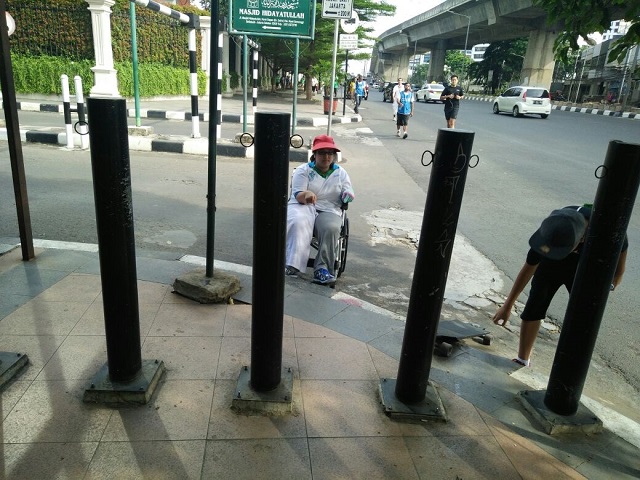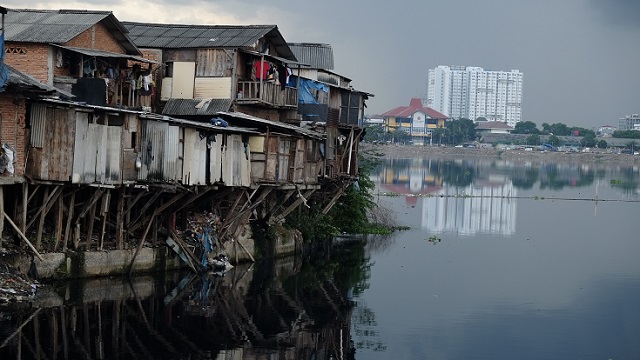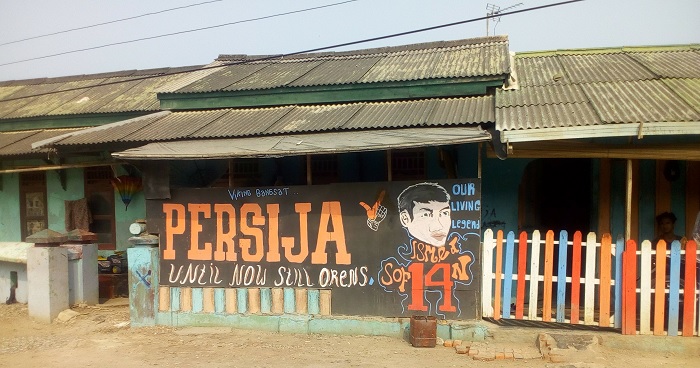People with disabilities are being left behind by Jakarta’s massive infrastructure developments
In 2012 Indonesian disability activists established Jakarta Barrier Free Tourism (JBFT), which is now an active community of around 140 people that inspects local tourist destinations to see how user-friendly they are for people with disabilities. Their ultimate aim is to help people with disabilities get better access to various tourism facilities provided by the government, including museums, Jakarta’s old city and Ragunan Zoo.
JBFT’s 2015 assessment found that most of these and other public facilities in Jakarta are far from disability friendly, and hazards threaten to plague the many new infrastructure developments that the government has planned. The city is currently dotted with construction sites that promise new flyover bridges and underpasses for private vehicles as well as Mass Rapid Transit (MRT) and Light Rail Transit (LRT) systems for public transport. The government is also building 5177 new apartments to accommodate the ever-increasing number of people moving to the city. A network of new footpaths is also being built for pedestrians.
Such massive infrastructure developments will certainly improve the quality of life for most people who live and work in Jakarta. But, as predicted by JBFT, people with disabilities will probably miss out for reasons such as bus stops not being easily accessible for wheelchair users, train stations not making their announcements understandable for people with hearing impairments, and footpaths that are like obstacle courses (even for people who can see).
This state of affairs is largely because government officials do not refer to the Technical Guide to Accessibility Requirements for Public Roads when developing new facilities. Also, they rarely – if ever – involve people with disabilities in planning processes. Given this situation, it is easy to imagine why even public infrastructure is not made in such a way that people with disabilities can also make use of it.
The long road to access
The central government has been talking seriously about improving access for people with disabilities for over a decade. In 2006, Public Works Minister Djoko Kirmanto issued a regulation that provided more technical guidance on how to make all facilities user-friendly for people with disabilities. According to these rules, all new buildings and certain other environments must reach a set standard of accessibility. The government went even further 10 years later, enacting the Persons with Disabilities Law that also sets minimum standards for access to public transport and other services. One year later, in 2017, the minister for public works issued another regulation clarifying various matters and updating terminology to match the 2016 law.
Despite these gains, poor implementation means that many old public facilities have not been made user-friendly for people with disabilities. For example, blind people continue to find it hard to use footpaths, even though there is tactile paving that ought to guide them. The guides are often obstructed by flower pots or hidden under street vendors’ carts. To make things worse, many of Jakarta’s footpaths are not safe for wheelchair users. More often than not footpaths do not have sloping edges meaning wheelchairs cannot mount and alight without assistance. Some footpaths are even blocked off by iron barriers, installed to prevent motorcycles from using them as an alternative road.
Nor does the Transjakarta Bus network – the most extensive public transport system in the city – do much to improve accessibility for people with disabilities. To get to most bus stops, passengers must use stairs, and at some major interchanges, such as at Semanggi, travellers need to climb dozens of flights of stairs to access the platform.
Conditions at commuter line train stations in Jakarta are no better. According to the Jakarta Legal Aid Institute (LBH) in 2015, 10 train stations fell short of legal standards for accessibility. Breaches of the law included train doors being 10 centimetres higher than the platform meaning wheelchair users had to be lifted to get on board. Another issue was that main entrances were too narrow resulting in passengers instead climbing a ladder to reach the platform.
Awareness of the problem
The lack of access is due to several factors. First, social sensitivity to the special needs of persons with disabilities is generally quite low in Indonesia. Most Indonesians do not have a general, let alone nuanced, understanding of disability, and society tends not to see disabled people as citizens with an equal right to enjoy the benefits of economic development. Government data show that as a result people with disabilities are 30 to 50 per cent more likely to be poor than non-disabled people, especially in urban areas.
Second, the government is not doing enough to address this problem. Information about accessibility is not widely disseminated to service providers. For example, those who issue building permits, and other officials, do little to make sure regulations are followed. Furthermore when the law is broken, there is not much in the way of sanctions.
Third, people with disabilities are not involved in routine design and evaluation processes for building and maintaining public facilities in Jakarta. All too often, this means that government officials and developers claim that new public facilities are accessible to disabled people, but in practice, disabled people cannot easily make use of them.
The JBFT community has provided recommendations for fixing these issues to the Jakarta government with the expectation that public facilities will be made more accessible for people with disabilities. Going forward these activists aspire to helping make Jakarta a user-friendly city for everyone, including people with disabilities.
Bahrul Fuad (cakfumu@gmail.com) is a PhD candidate in the Department of Sociology at the University of Indonesia.














